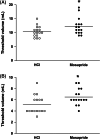Effects of esophageal acid infusion vs mosapride on distension-induced secondary peristalsis in humans
- PMID: 30897296
- PMCID: PMC11900669
- DOI: 10.1002/kjm2.12059
Effects of esophageal acid infusion vs mosapride on distension-induced secondary peristalsis in humans
Abstract
Secondary peristalsis contributes to the clearance of the refluxate from the esophagus. Acute administration of 5-hydroxytryptamine 4 (5-HT4 ) receptors agonist, mosapride or esophageal infusion of hydrochloric acid (HCl) facilitates secondary peristalsis. The aim of this study was to determine whether esophageal acid infusion and administration of mosapride had different effects on secondary peristalsis. Secondary peristalsis was performed with esophageal distension with rapid and slow air injections in 16 healthy subjects. We performed two separate sessions with HCl (0.1 N) and 40 mg oral mosapride to compare their influence on secondary peristaltic parameters. The threshold volume of secondary peristalsis was significantly lower with HCl infusion than mosapride (P = 0.01) by slow air injections. The threshold volume to generate secondary peristalsis was significantly lower with HCl infusion than mosapride (P = 0.002) by rapid air injections. More secondary peristalsis was trigged by rapid air injections after HCl infusion than mosapride (P = 0.003). Infusion of HCl or mosapride administration has similar effects on peristaltic wave amplitude and duration of primary and secondary peristalsis. Acute esophageal acid infusion can induce greater mechanosensitivity to distension-induced secondary peristalsis than 5-HT4 receptors agonist mosapride. The data suggest that acid-sensitive afferents are more likely to contribute to sensory modulation of esophageal secondary peristalsis; however, the motility aspects of secondary peristalsis are comparable between acute esophageal acidification and 5-HT4 receptors activation via mosapride.
Keywords: 5-HT4 receptors; HCl; esophageal peristalsis; mosapride; secondary peristalsis.
© 2019 The Authors. The Kaohsiung Journal of Medical Sciences published by John Wiley & Sons Australia on behalf of Kaohsiung Medical University.
Conflict of interest statement
All authors declare no conflict of interest.
Figures


Similar articles
-
Effects of mosapride on esophageal secondary peristalsis in humans.Neurogastroenterol Motil. 2011 Jul;23(7):606-e249. doi: 10.1111/j.1365-2982.2011.01714.x. Epub 2011 Apr 19. Neurogastroenterol Motil. 2011. PMID: 21501334 Clinical Trial.
-
Differences in the Control of Secondary Peristalsis in the Human Esophagus: Influence of the 5-HT4 Receptor versus the TRPV1 Receptor.PLoS One. 2016 Jul 20;11(7):e0159452. doi: 10.1371/journal.pone.0159452. eCollection 2016. PLoS One. 2016. PMID: 27438088 Free PMC article.
-
Influence of intraluminal acidification on esophageal secondary peristalsis in humans.Dig Dis Sci. 2013 Jul;58(7):1948-54. doi: 10.1007/s10620-013-2584-2. Epub 2013 Feb 8. Dig Dis Sci. 2013. PMID: 23392747 Clinical Trial.
-
Effects of mosapride on secondary peristalsis in patients with ineffective esophageal motility.Scand J Gastroenterol. 2013 Dec;48(12):1363-70. doi: 10.3109/00365521.2013.840856. Epub 2013 Oct 8. Scand J Gastroenterol. 2013. PMID: 24099237 Clinical Trial.
-
Comparable effects of capsaicin-containing red pepper sauce and hydrochloric acid on secondary peristalsis in humans.J Gastroenterol Hepatol. 2013 Nov;28(11):1712-6. doi: 10.1111/jgh.12284. J Gastroenterol Hepatol. 2013. PMID: 23730892
References
-
- Creamer B, Schlegel J. Motor responses of the esophagus to distention. J Appl Physiol. 1957;10(3):498–504. - PubMed
MeSH terms
Substances
Grants and funding
LinkOut - more resources
Full Text Sources

